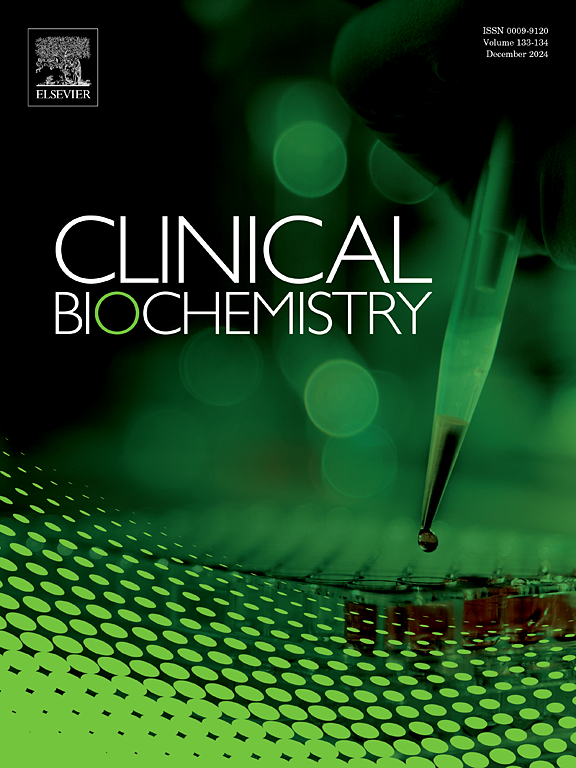Re-evaluating the utility of iron indices in hereditary hemochromatosis genotyping: A retrospective study
IF 2.5
3区 医学
Q2 MEDICAL LABORATORY TECHNOLOGY
引用次数: 0
Abstract
Introduction
Hereditary hemochromatosis (HH), associated with C282Y or H63D mutations in the HFE gene, is the commonest genetic disorder in Canada. The majority of HH cases are attributable to C282Y homozygosity which can precipitate iron overload and organ damage, but with low penetrance. Elevated transferrin saturation (TSat) and ferritin levels are key biochemical indicators of iron overload in C282Y homozygotes. This retrospective study examined TSat and ferritin levels as predictors of C282Y homozygosity in genotyped patients.
Methods
This study included 23,432 individuals from Maritime provinces who underwent HFE genotyping from 2009 to 2022. Those with available biomarkers (TSat, ferritin, ALT) were included in the study sample. C282Y and H63D variants were identified based on HFE genotying. Median values for each biomarker were compared across genotypes and their diagnostic performance in predicting C282Y homozygosity evaluated using ROC analysis.
Results
1241 individuals (5.3 %) showed C282Y homozygosity, marking the largest North American study cohort. C282Y homozygotes showed significantly higher median TSat and ferritin levels than wildtypes. TSat showed the best diagnostic performance in detecting C282Y homozygosity (AUC = 0.82, 95 % CI: 0.78–0.85), outperforming ferritin (AUC = 0.54, 95 % CI: 0.50–0.58) and ALT (AUC = 0.59, 95 % CI: 0.56–0.63). TSat thresholds of 32 % (females) and 35 % (males) had a 90 % sensitivity for C282Y homozygosity. Using thresholds of TSat ≤46 % and ferritin ≤370 µg/L (females), and TSat ≤49 % and ferritin ≤703 µg/L (males) reduced the need for genotyping by up to 50 % without missing significant biochemical iron overload cases. Implementing this strategy across 23,432 tests could save $1,701,163 and potentially reduce unnecessary downstream management.
Conclusion
Our study suggests significant efficiency savings by implementing an algorithm to reduce unnecessary HFE genotyping and alleviate unwarranted genetic testing anxiety.
重新评价铁指标在遗传性血色素沉着病基因分型中的应用:一项回顾性研究
遗传性血色素沉着症(HH)与HFE基因的C282Y或H63D突变相关,是加拿大最常见的遗传性疾病。大多数HH病例可归因于C282Y纯合性,可导致铁超载和器官损伤,但外显率低。转铁蛋白饱和度(TSat)和铁蛋白水平升高是C282Y纯合子铁超载的关键生化指标。本回顾性研究检验了TSat和铁蛋白水平作为基因型患者C282Y纯合性的预测因子。方法本研究纳入2009 - 2022年来自沿海省份的23,432例HFE基因分型患者。具有可用生物标志物(TSat、铁蛋白、ALT)者纳入研究样本。通过HFE基因测序鉴定C282Y和H63D变异。比较各基因型生物标志物的中位数,并使用ROC分析评估其预测C282Y纯合性的诊断性能。结果1241例(5.3%)个体显示C282Y纯合性,是北美最大的研究队列。C282Y纯合子的TSat和铁蛋白水平中位数明显高于野生型。TSat对C282Y纯合性的诊断效果最好(AUC = 0.82, 95% CI: 0.78 ~ 0.85),优于铁蛋白(AUC = 0.54, 95% CI: 0.50 ~ 0.58)和ALT (AUC = 0.59, 95% CI: 0.56 ~ 0.63)。TSat阈值为32%(女性)和35%(男性),对C282Y纯合性的敏感性为90%。使用TSat≤46%和铁蛋白≤370µg/L(女性)以及TSat≤49%和铁蛋白≤703µg/L(男性)的阈值,在不遗漏显著生化铁超载病例的情况下,减少了高达50%的基因分型需求。在23,432个测试中实施该策略可以节省1,701,163美元,并可能减少不必要的下游管理。结论本研究表明,通过实施一种算法来减少不必要的HFE基因分型和减轻不必要的基因检测焦虑,可以显著节省效率。
本文章由计算机程序翻译,如有差异,请以英文原文为准。
求助全文
约1分钟内获得全文
求助全文
来源期刊

Clinical biochemistry
医学-医学实验技术
CiteScore
5.10
自引率
0.00%
发文量
151
审稿时长
25 days
期刊介绍:
Clinical Biochemistry publishes articles relating to clinical chemistry, molecular biology and genetics, therapeutic drug monitoring and toxicology, laboratory immunology and laboratory medicine in general, with the focus on analytical and clinical investigation of laboratory tests in humans used for diagnosis, prognosis, treatment and therapy, and monitoring of disease.
 求助内容:
求助内容: 应助结果提醒方式:
应助结果提醒方式:


